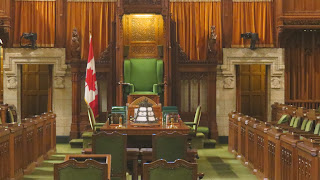 |
| Parliament Photo from Robert Linsdell |
The Reform Act, 2013 is an act I think has a lot of potential. My last post was about the fact that it allows the caucus to strip the leader of power and make them just another MP. Another thing it does is it limits the ability of the leader of a party to remove elected representatives chosen by the members and elected by voters. This is very important because in modern times being a member of a party is a critical part of the voting equation. The ability of the leader to kick someone out because she or he stands up to the leader is undemocratic. Jean Chrétien was known for throwing people out of the party if they didn’t do things his way. This enforcing of groupthink is detrimental to democracy and the health of our government.
Again, caucus is defined by this bill as everyone elected to parliament and belonging to the same party:
“caucus” means a group composed solely of members of the House of Commons who are members of the same recognized party.
So, how does removing and readmitting a member work?
Removing a member of Caucus
The bill would mandate that there would be only one way to remove an elected member of the party, making that member an independent MP. Only if 15% of the caucus ask the chair to review that member’s membership, and then a majority of the caucus votes to remove that member:
49.2 A member of a caucus may only be expelled from it if
(a) the caucus chair has received a written notice signed by at least 15% of the members of the caucus requesting that the member’s membership be reviewed at a meeting of the caucus; and
(b) the expulsion of the member is approved by a majority vote by secret ballot of the caucus members present at that meeting.
This removes power from the leader to expel people that she or he does not like. Historically, I am only aware of the leader decreeing (you know, like a king) that some member of caucus has to go, and they unceremoniously strip that MP of any affiliation with the party. If this bill passes the party still retains the ability to kick someone out if they must. That is a good thing.
Academically, I noticed that this also means that there is no other way the party can remove the member. A party can’t put together other ways to remove a member. For example, now an electoral district association cannot vote to remove their support from that candidate while she or he is sitting. I don’t think that any party allows this to happen. But such a solution cannot be implemented if this bill passes. That would be a method I think would be good. However, since no party has that method in their constitution that I am aware of, it’s a moot point.
But you may ask yourself, ‘what about adding someone back in?’
Remitting a member to caucus
The bill says that there are only two ways a member who has been expelled may return to the caucus. The first is that the member is re-elected in an election (a by-election or general election) as a candidate for that party, or 15% of the caucus asks to have a vote on making that person a member again, and the caucus has a majority vote to let her or him back in the party:
49.3 A member of the House of Commons who has been expelled from the caucus of a party may only be readmitted to the caucus
(a) if the member is re-elected to the House of Commons as a candidate for that party; or
(b) if
(i) the caucus chair has received a written notice signed by at least 15% of the members of the caucus requesting that the member’s readmission to the caucus be considered at a meeting of the caucus, and
(ii) the readmission of the member is approved by a majority vote by secret ballot of the caucus members present at that meeting.
So, the first way a member can rejoin the party happens if the local electoral district association (EDA) has a nomination meeting and that person wins again. It should be noted that the Reform Act does specify how a candidate is selected and how she or he gets approval to use the party’s name. (Hint: it’s not from the leader or the central party, but the EDA itself. The second way listed is obvious.
Note that the caucus here cannot override the wishes of the rank and file from that EDA. The local voters can always send that MP back as a member of the party. In fact, this has been one of the criticism of this bill: that there is no way for the central party to stop certain candidates from running. While I support limiting the leader’s ability to put in whoever they want, or denying whoever they want, it also means they cannot stop politically untenable people from running. And in Canada we have had some scandalous people run.
One drawback I’ve not seen raised is that an MP cannot simply cross the floor and join another party as has happened before.
Another major section of the bill is determining who can run under a party name, which I will discuss next time.
More reading:
- See the official Parliament page for Bill C-559 ‘The Reform Act, 2013’ and read the latest version (if any changes have been made).
- Read my summary of the Reform Act, 2013.
- Read my summary of how the Reform Act would allow the caucus can remove the leader of the party.
- 2013-12-11: Added the second last paragraph, starting ‘One drawback…’
